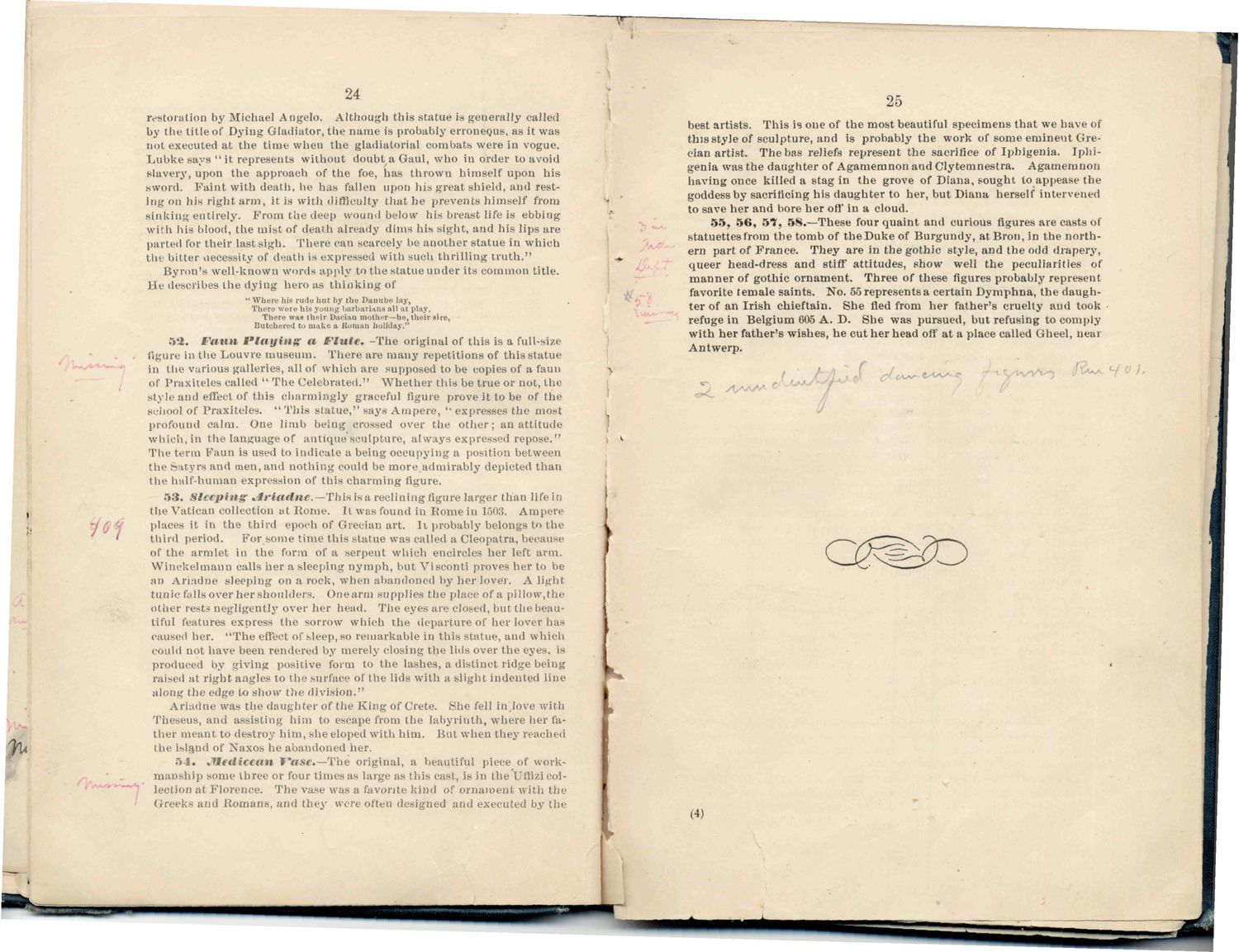| |
| |
Caption: Book - Gregory Art Collection Catalog (Gregory)
This is a reduced-resolution page image for fast online browsing.

EXTRACTED TEXT FROM PAGE:
24 restoration by Michael Angelo. Although this .statue la generally called by the title of Dying Gladiator, the name is probably erroneous, as it was Dot executed at the time when the gladiatorial combats were in vogue. Lubke says " it represents without doubt a Gaul, who in order to avoid slavery, upon the approach of the foe, has thrown himself upon his sword. Faint with death, he has fallen upon his great shield, and resting on his right arm, it is with difficulty that he prevents himself from sinking entirely. From the deep wound below his breast HIV is ebbing with his blood, the mist of death already dims his sight, and his lips are parted for their last sigh. There can scarcely be another statue in which the bitter necessity of death is expressed with such thrilling truth." Byron's well-known words apply to the statue under its common title. He describes the dying hero as thinking of " When bis rinlu but by tho Danube lay, were bia young barbarians all at play. 25 best artists. This is one of the most beautiful specimens that we have of this style of sculpture, and is probably the work of some eminent Grecian artist. The has reliefs represent the sacrifice of Iphigenia. Iphigenia was the daughter of Agamemnon and Clytemnestra. Agamemnon having once killed a stag in the grove of Diana, sought to appease the goddess by sacrificing his daughter to her, but Diana herself intervened to save her and bore her off in a cloud. 5 5 , 5 6 , 5 7 , 58.—These four quaint and curious figures are casts of statuettes from the tomb of theDuke of Burgundy, atBron, in the northern part of France. They are in the gothic style, and the odd drapery, queer head-dress and stiff attitudes, show well the peculiarities of manner of gothic ornament. Three of these figures probably represent favorite temale saints. No. 55 represents a certain Dymphna, the daughter of an Irish chieftain. She fled from her father's cruelty and took refuge in Belgium 605 A. D. She was pursued, but refusing to comply with her father's wishes, he cut her head off at a place called Gheel, near Antwerp. Batohered to make aftomanholiday.1 5 2 . fVi ifii Playing a Flute. -The original of this is a full-size figure in the Louvre museum. There are many repetitions of this statue in the various galleries, all of which are supposed to be copies of a faun of Praxiteles called " The Celebrated." Whether this be true or not, the style and effect of this charmingly graceful figure prove it to be of the s-.-iiool of Praxiteles. " This statue," says Ampere, " expresses the most profound calm. One limb being crossed over the other; an attitude which, in the language of antique sculpture, always expressed repose." The term Faun is used to indicate a being occupying a position between the Satyrs and men, and nothing could be more admirably depicted than the half-human expression of this charming figure. 5 3 . Sleeping .Irindne.— This is a reclining figure larger than life in the Vatican collection at Home. It was found in Home in 1603. Ampere places it in the third epoch of Grecian art. I t probably belongs to the third period. For some time this statue was called a Cleopatra, because of the armlet in the form of a serpent which encircles her left arm. Winckelmann calls her a sleeping nymph, but Visconti proves her to be an Ariadne sleeping on a rock, when abandoned by her lover. A light tunic falls over her shoulders. One arm supplies the place of a pillow,the other rest- negligently over her bead. The eyes are closed, but the beautiful features express the sorrow which the departure of her lover has caused her. "The effect of sleep, so remarkable in this statue, and which could not have been rendered by merely closing the lids over the eyes, is produced by giving positive form to the lashes, a distinct ridge lieing raised at right angles to the surface of the lids with a slight indented line along the edge to show the division." Ariadne was the daughter of the King of Crete. She fell in.love with Theseus, and assisting him to escape from the labyrinth, where her father meant to destroy him, she eloped with him. But when they reached I lie islarid id' Naxos he abandoned her. 5 4 . .lletlicetin Vase.—The original, a beautiful piece of workmanship some three or four times as large as this cast, is in the I'lli/.icollection at Florence. The vase was a favorite kind of ornament, with the (i reeks and Romans, and they were often designed and executed by the T h e r e was t h e i r DaoiaD. mother —he, their siro, (4)
| |